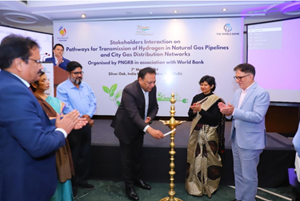News
PNGRB organized a mega-stakeholder interaction on H2 transmission in natural gas pipelines (1)
Petroleum and Natural Gas Regulatory Board (PNGRB) is progressing on the task of transporting green H2 through natural gas transmission lines by blending H2 with natural gas. PNGRB is considering natural gas transmission lines as a first choice for the transportation of green H2 as currently total 33,000 km of natural gas transmission pipelines network has been authorized, out of which 24,000 km is operational and rest is under construction. These natural gas pipelines will bridge the gap between regions with rich renewable energy resources (having high supply of green H2) and H2 consuming centers such as fertilizer plants, refineries and heavy iron and steel industries.
PNGRB organized a mega-stakeholder interaction on March 7, 2024, to discuss and gather inputs on the draft report of the study undertaken by PNGRB in association with World Bank and study partner ICF, to develop “Pathways for Hydrogen transmission in Natural gas pipelines and City Gas Distribution networks.”
Dr Anil Kumar Jain, Chairperson, PNGRB in keynote address highlighted the importance of H2 blending in natural gas pipelines and CGD networks, expressed that PNGRB is committed to ensure safety and integrity of related infrastructure. PNGRB is also in process of formulating a global level regulatory regime for the transportation of green H2.
In the stakeholder interaction, representatives from various ministries, statutory/autonomous bodies, research institutions and oil and gas entities shared ideas about prospects of H2 in India. The event included presentation from ICF on draft study report besides presentations from the Petroleum and Explosives Safety Organization (PESO), GAIL (India) Limited and Gujarat Gas Limited (GGL) towards new initiatives being undertaken for promotion of H2 in the country.
Recognizing the potential benefits of H2 blending in the natural gas and CGD sector, PNGRB since August-2023 is undertaking this important study in collaboration with the World Bank. The study comprises of mapping demand and supply of H2, technical assessment of the existing pipeline network for its compatibility, commercial assessment of pipeline sector, identifying bottlenecks in of policy and regulatory framework and framing of roadmap milestones till 2040 for expeditious implementation of H2 blending in India.
As per outcomes of draft study report, the total H2 demand in India is expected to increase from current demand of 6 MMtpy–7 MMtpy to 16 MMtpy–18.5 MMtpy by 2040. Major contributors of this projected demand will be from ammonia, refineries and transport sector. The study also suggested blending limits for various components such as for transmission pipeline, compressors, gas turbines, gas meters, domestic appliances, CNG vehicles and other associated equipment and fittings used in the natural gas pipelines and city gas distribution networks. Beyond these blending limits study also projected additional CAPEX and OPEX requirements towards equipment and fittings.
This mega-stakeholder interaction will also pave way forward to achieve the target of 5 MMtpy green H2 production by 2030, set by Government of India under its clean energy agenda through its national green H2 mission.


